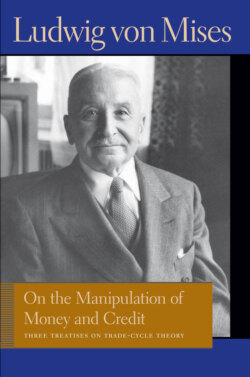Читать книгу On the Manipulation of Money and Credit - Людвиг фон Мизес - Страница 7
На сайте Литреса книга снята с продажи.
FOREWORD
ОглавлениеThis book is a collection of papers written by Mises during the 1920s and 1930s on money and the boom/bust trade cycle, the field in which one finds perhaps Mises’s greatest contribution to economics. The papers included in this volume were first published in English with other materials by Free Market Books in 1978 and were reprinted later by the Ludwig von Mises Institute under the title The Causes of Economic Crisis and Other Essays Before and After the Great Depression (2006). Although Mises had long been interested in all aspects of monetary theory, these particular essays are devoted more specifically to his theory of monetary crises than are his other more general works.
Soon after Mises had earned his doctorate from the University of Vienna, he determined to write a book on money. To do a thorough job, he thought he should start with direct exchange, but he didn’t believe he would have time, as he saw war looming in Europe. Although he had completed the compulsory military service required of all young men in the Austria-Hungary of his day, he would be subject to recall if war came. So he didn’t begin with direct exchange but with indirect (nonbarter) exchange, building on the subjective marginal utility theory of value developed by his Austrian predecessors Carl Menger and Eugen von Böhm-Bawerk. His explanation was in direct opposition to the then-popular “state theory of money,” which defined money as whatever the government decreed to be money.
That book, titled in German Theorie des Geldes und der Umlaufsmittel, appeared in 1912.1 Mises explained there that money was a market phenomenon, which developed out of barter as individuals traded with one another in the attempt to discover something they could use as a medium of exchange. After dealing with money, Mises discussed banking. In this 1912 book he first raised the possibility that the banks might lower interest rates below market rates by increasing their issue of fiduciary media. Mises even considered that a bank might increase the quantity of money so much that its purchasing power might go down to 1/100th of its previous value, or even less if the monetary increases were continued. In that case, he then posited its purchasing power might decline until businesses would avoid it altogether and find something else to use as a medium of exchange. His contemporaries dismissed and discounted this possibility.
Mises described how the inflation (monetary expansion) fostered by the banks would lead to widespread price increases and economic malinvestment; however, if and when the banks stopped inflating, businesses would crash, the economy would stagnate, and all prices of goods and services would be readjusted. Thus, in 1912 Mises laid the groundwork for explaining the causes of the economic crises which afflicted capitalistic economies periodically and how to prevent them. But the world paid little attention; Mises’s book was practically ignored, even ridiculed.
Mises’s work in economics was interrupted by World War I, when he was called back into military service and served on the Eastern front. After the war, however, he continued to write on money. During the 1920s and 1930s, he built on and expanded the general monetary theory first set forth in The Theory of Money and Credit, and subsequently elaborated upon it in his later major works on economics, the German-language Nationalökonomie (1940) and its English language version, Human Action (1949).2 The several monographs included in this present collection, written between the two World Wars, are devoted specifically to the theory of the trade cycle and include some of Mises’s most important contributions to monetary theory.
My economist and historian husband, Percy L. Greaves, Jr.—like me, a longtime student of Mises—selected the papers included in this anthology as Mises’s most important papers on money which had not previously appeared in English. The 1978 edition and 2006 reprint included an epilogue with articles on monetary theory by my husband. The epilogue has been omitted from this Liberty Fund edition in order to focus solely on the ideas of Mises.
In reading these works, keep in mind that Mises used the term “liberal” in the classical sense to refer to a free society and the term “inflation” to mean an increase in the quantity of money and credit, rather than one of the inevitable consequences of that increase, higher prices.
Bettina Bien Greaves
May 2008
